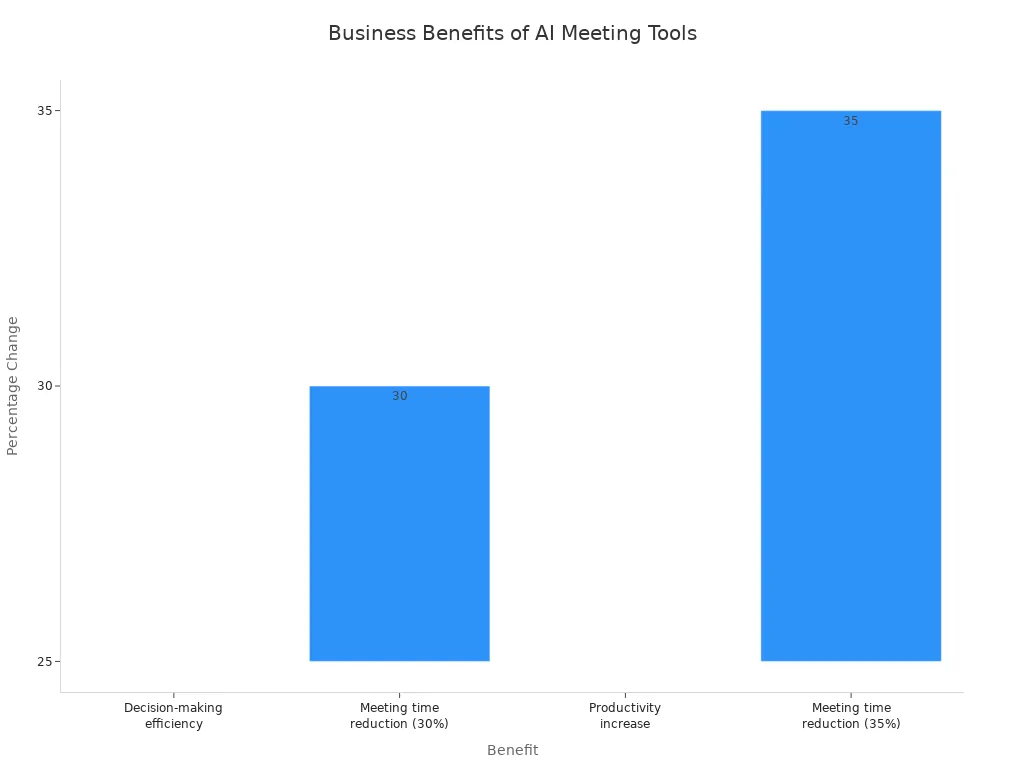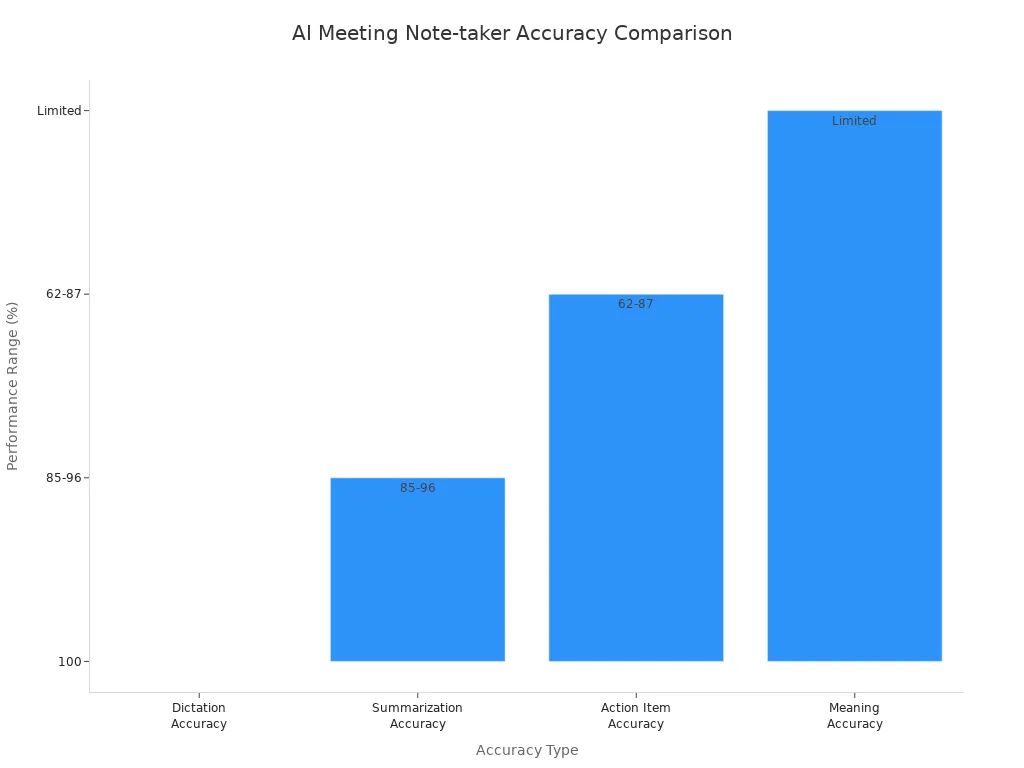Choosing the right AI Business Recorder can help your team work better. You want easy-to-read transcriptions, smart meeting summaries, and tools that match how you work.
-
80% of companies say they get more work done after using AI meeting recorders.
Look at the main things businesses think about:
|
Factor |
Description |
|---|---|
|
Transcription Accuracy |
70% of groups say this is very important when picking meeting software. |
|
Scalability |
Many tools, like Google Cloud Speech-to-Text, can grow to fit what you need. |
|
Security and Compliance |
You need strong safety, like data encryption and following rules. |
|
Integration Capabilities |
Easy connection with business tools helps your team do better. |
Try a few choices and listen to what users say before you decide.
Key Takeaways
-
Pick an AI meeting recorder with very good transcription accuracy. Try to get tools that are at least 95% accurate in quiet rooms. This will help you spend less time fixing mistakes.
-
Find features like meeting summaries and action item lists. These features help your team see important points fast. They also help everyone remember what to do after meetings.
-
Make sure the tool works well with your current software. This helps you record, transcribe, and share notes easily. You will not need to switch between many platforms.
-
Put security and compliance first. Choose tools that use data encryption and follow rules like GDPR. This keeps your important information safe.
-
Try out different tools with your team before you choose one. Testing helps you find which recorder works best for your team. It also shows which one fits your needs.
What Is an AI Business Recorder?
Definition
An ai business recorder is a smart tool for meetings. It helps you keep track of everything people say. You do not need to write notes by hand. The tool uses artificial intelligence to listen and record what is said. It turns your talks into easy-to-read text.
Here are some things an ai business recorder can do:
-
It makes transcriptions and captions for each meeting.
-
It finds important parts and lets you edit notes fast.
-
It adds subtitles and notes in many languages.
-
It uses AI avatars and dubbing for other languages.
-
It gives you editing tools and helps manage your work.
You may wonder how ai meeting note-takers work. They use smart speech recognition and language processing. These tools hear voices, know who is talking, and sort things as they happen. You get good records without doing extra work.
Benefits
Using an ai business recorder makes work easier. It helps you save time and be more accurate. Your team can work together better.
Did you know? AI meeting tools help people make choices 25% faster and can make meetings 35% shorter.
|
Benefit |
Measurement |
|---|---|
|
Decision-making efficiency |
|
|
Meeting time reduction |
Up to 30% decrease in meeting time |
|
Productivity increase |
25% increase in productivity |
|
Meeting time reduction |
35% reduction in meeting time |

You also get better transcripts, even with hard audio. Many companies see up to 95% accuracy. Teams save time because the ai business recorder does the tough jobs. Sales teams can save over 4 hours each week. Admin work can drop by 70%. Your team can follow up faster, keep clients happy, and work well together.
Key Features of AI Meeting Note-Taker

When you pick an ai meeting note-taker, you want to know what makes it good. The right features help you save time and keep your team focused. They also make meetings more helpful. Let’s look at the most important things you should check in a note-taker.
Transcription Accuracy
Your ai meeting note-taker should catch every word people say. Some tools can be right 95% of the time if things are quiet. Others are not as good. Most tools get about 61% of words right. If your office is loud or people have different accents, you need a tool that works well anyway. High transcription accuracy means you do not have to fix many mistakes. You can get your work done faster. Clear and correct meeting notes help everyone understand.
Tip: Try the note-taker in your real meetings before you choose. This helps you see if it works with your team’s voices and how you meet.
Meeting Summaries
You do not want to read a long meeting transcript every time. Meeting summaries help with this. A good ai meeting note-taker makes short and easy-to-read summaries. These show the main ideas, choices, and tasks. You can see what happened in just a few minutes. Summaries also help people who missed the meeting catch up fast. Many companies say meeting summaries help workers get more done and follow up on tasks.
|
Feature |
Description |
|---|---|
|
Meeting summaries |
Makes quick reviews by summarizing meeting notes and transcripts. |
|
Action items |
Lists action items so everyone knows what to do after the meeting. |
|
Editing capabilities |
Lets you change and add to notes after the meeting for better accuracy. |
|
Attachments |
Lets you add files to meeting summaries for more details. |
Speaker Identification
Sometimes you read a transcript and do not know who spoke. Speaker identification fixes this. The ai meeting note-taker marks who is talking. Tools like Otter.ai and TL;DV do this well. In planned meetings, the tool can be right every time. In real meetings, it is still very good, usually over 84%. This helps you know who made choices and who to talk to later.

Integration
Your ai meeting note-taker should work with the tools you already use. The best ones connect with Google Meet, Microsoft Teams, Zoom, and even CRMs or project apps. This means you do not have to switch between lots of tools. You can start a meeting, record it, and send summaries to your team all in one place. Integration saves time and keeps your work neat.
|
AI Meeting Note-Taker |
|
|---|---|
|
Sembly Notes |
Google Meet, Microsoft Teams, Cisco Webex, Zoom, CRMs, collaboration, project and task management apps |
|
Granola |
All platforms (no meeting bots needed) |
Security
You talk about private things in meetings. Your ai meeting note-taker must keep your data safe. Look for things like data encryption, access controls, and following rules like GDPR or SOC 2. The best tools use AES encryption and let you choose who can see your meeting notes. If you work in healthcare or finance, check for HIPAA or other special rules. Security keeps your business and clients safe.
Note: In many places, you must ask everyone before recording. Some states need only one person to agree, but others—like California—need everyone to say yes.
|
Aspect |
Description |
|---|---|
|
Some states allow one person to agree, others need two. |
|
|
GDPR Impact |
You must get clear consent to record; people can ask for their data to be deleted. |
|
HIPAA Regulations |
Patients must agree to recording; health info must be handled carefully. |
Recording Alerts
Recording alerts help you follow the law and be fair. The ai meeting note-taker tells everyone when it starts recording. This helps you follow privacy rules and builds trust. You need to know the rules in your state or country. Some places need everyone to agree before you record. The note-taker should make it easy to get consent and remind people about the recording.
-
Check the consent rules in every state where your company works.
-
Make a clear process for getting consent in all meetings.
-
Teach workers and managers about these consent rules.
Analytics
Analytics turn your meeting data into helpful information. The ai meeting note-taker tracks who joins, how long meetings last, and what topics are discussed. You can see patterns and find problems. This helps you make better choices. Analytics help you waste less time and make meetings better. Some tools even show which meetings have the most tasks or who talks the most.
AI meeting note-takers give analytics that show what happens in meetings, who joins, and how people act. These insights help you get more done and avoid too many meetings.
Here are the features business users ask for most:
|
Feature |
Description |
|---|---|
|
Full meeting transcripts |
Gives you the whole meeting written out so you can review it. |
|
Live transcription and captions |
Shows what is said in real time and adds captions for everyone. |
|
Dynamic highlight clips |
Lets you make short clips from meetings to share or watch again. |
|
Searchable transcripts |
Lets you search meeting notes to find what you need fast. |
|
Comprehensive summaries |
Makes summaries of meetings to save time and help you get more done. |
|
Keywords and topics categorization |
Puts meetings into groups with keywords and topics for better organization. |
When you pick an ai meeting note-taker with these features, your meetings become more useful, open, and safe. Your team can work smarter and not harder.
Choosing an AI Meeting Note-Taker
Comparison Tips
You want to find the best tool for your team. Start by looking at the features to look for in each AI meeting recorder. Some tools offer better transcription, while others focus on smart meeting summaries or easy integration. You should check how each tool handles output quality. Does it give you clear and accurate notes every time?
Here’s a table to help you compare top AI meeting assistant tools:
|
Criteria |
Description |
|---|---|
|
Features |
Look for transcription quality, meeting summaries, and speaker identification. |
|
Pricing |
Compare costs for individuals, teams, and larger businesses. |
|
User Interface |
See if the tool is easy for everyone to use. |
|
Accuracy |
Test how well the tool transcribes your meetings. |
|
Integration Capabilities |
Make sure it works with your current software and platforms. |
You might work alone or with a big team. Here are some top picks for different groups:
-
Solo professionals and freelancers often choose Jamie AI or Granola.
-
Small teams like Fireflies.ai or Granola.
-
Medium businesses go for Fireflies.ai or Fellow.
-
Enterprise organizations pick Fellow or Fireflies.ai Enterprise.
-
If you use Notion, Notion AI or Fireflies.ai work well.
Tip: Always match the tool’s features to your workflow. The right choice makes your meetings smoother and your notes more useful.
Trial Runs
Testing a tool before you buy helps you avoid surprises. Most AI meeting note-takers offer a free version. You can sign up and try the transcription and meeting summarization features. This lets you see if the tool fits your needs for effective meeting notes.
Try these steps for a good trial run:
-
Sign up for a free version. Use it in a real meeting to check the features to look for.
-
Check if the interface is easy to use. Can you upload and review notes quickly?
-
Ask your team for feedback. Do they find the notes helpful? Are action items clear? Does the tool make meetings easier?
You want a tool that gives you high output quality and saves you time. If your team likes the tool, you know you’re on the right track for choosing an ai meeting note-taker.
User Reviews
User reviews help you see what works in real life. People share their experiences with different tools. You can learn about problems or special features that matter to your business. Look for reviews that talk about quality, ease of use, and support.
When comparing top ai meeting assistant tools, check what users say about:
-
How well the tool handles noisy environments.
-
If the meeting summaries are clear and useful.
-
How easy it is to set up and use every day.
-
Whether the tool helps teams follow up on tasks.
Note: Reviews from businesses like yours give you the best clues. They show if the tool really delivers effective meeting notes and fits your workflow.
Choosing an ai recording tool is easier when you listen to real users and test the tool yourself. You get a clear picture of what works and what doesn’t. This way, you pick a tool that helps your team work smarter and faster.
Implementing AI-Powered Meeting Tools

Onboarding
Starting with ai-powered meeting tools is simple if you plan well. First, decide what your team wants to do with these tools. Then, pick the best platform for your business. You can choose a ready-made tool or a custom one. Tell everyone about the new tool and explain how it works. Share your AI disclosure policy with workers and clients. This helps everyone trust the tool and know what is happening.
Here are some tips for onboarding:
-
Give training that fits each person’s job.
-
Let people help each other learn. This makes learning faster.
-
Use video calls for training so everyone feels part of the team.
-
Watch how people use the tool and ask for their thoughts often.
Training
Training teaches your team how to use ai-powered meeting tools. Start with workshops where people can try the features. Give remote workers video lessons and short guides. Show admins how to use special settings. Teach team leaders how to set up group meetings. Help everyone use the tool in their daily work.
Giving things like user guides, videos, and support is important. These help everyone use the AI meeting recorder well.
Set clear rules for using the tool. Pick someone to be in charge of it. Make sure everyone knows how to keep data safe. Connect the tool to your normal work so it is easy to use.
Feedback
Feedback helps your ai-powered meeting tools work better. Talk to your team often. Use surveys to get their real opinions. Check how much time you save and how many meetings you have. Look for problems or things people want to change. Review how the tool works and change your rules if needed.
|
Challenge |
Description |
Solution |
|---|---|---|
|
Legal Vulnerabilities |
AI recordings can cause problems in court. |
Keep records correct and manage versions carefully. |
|
Technical Infrastructure |
You need good sound and fast internet. |
Take care of your systems and give tech help. |
|
Security and Confidentiality |
Private info must be kept safe. |
Use strong passwords and encryption. |
|
Quality Assurance |
You want meeting notes to be right. |
Check how the tool works and look for mistakes often. |
When you listen to your team and keep making things better, your ai-powered meeting tools will help you the most.
Choosing the right AI meeting recorder means looking at what matters most for your business. Focus on things like audio quality, transcription accuracy, speaker ID, and privacy. Make a list of your needs, compare your top choices, and check for strong security and easy integration with your tools. Take your time, test a few options, and ask your team for feedback. You can find a tool that fits your workflow and keeps your data safe. Start your search today and make every meeting count! 🚀
FAQ
How accurate are AI meeting recorders?
You can expect most AI meeting recorders to reach up to 95% accuracy in quiet settings. If your meetings have lots of background noise or strong accents, accuracy may drop. Always test the tool with your team first.
Can I use an AI meeting recorder with Zoom or Teams?
Yes! Most AI meeting recorders work with Zoom, Microsoft Teams, and Google Meet. You just connect the tool to your meeting platform. This makes it easy to record, transcribe, and share notes.
Is my data safe with AI meeting recorders?
You get strong security features like encryption and access controls. Many tools follow rules like GDPR or HIPAA. Always check the privacy policy before you choose a tool.
Do I need everyone’s permission to record a meeting?
You should ask everyone before you record. Some states need only one person to agree, but others require everyone’s consent. Always check local laws and let your team know when you start recording.
What if the AI makes mistakes in the transcript?
You can edit transcripts after the meeting. Most tools let you fix errors, add notes, or highlight important parts. This helps you keep your records clear and accurate.







0 comments